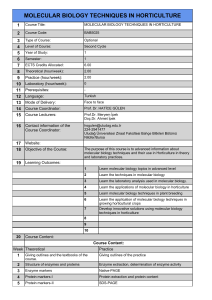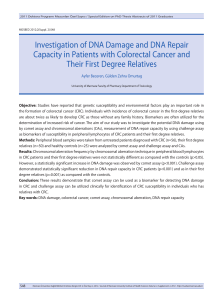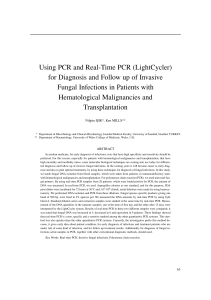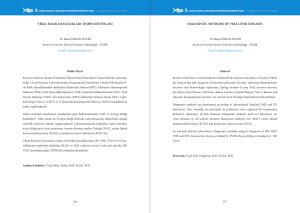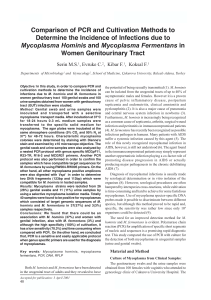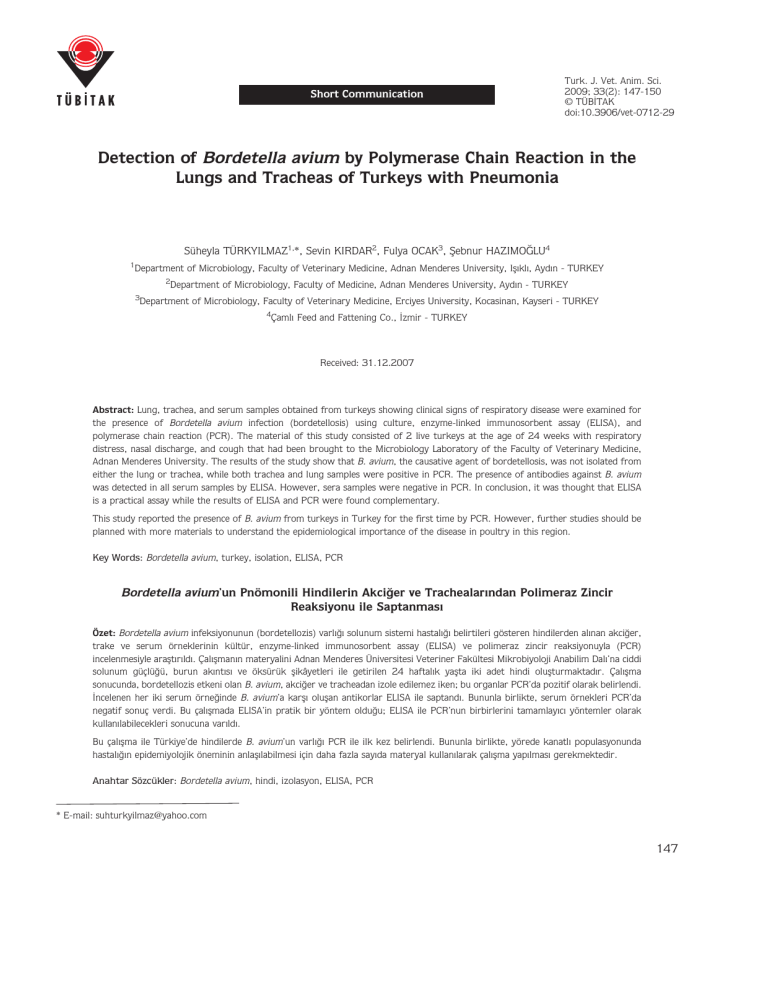
Short Communication
Turk. J. Vet. Anim. Sci.
2009; 33(2): 147-150
© TÜBİTAK
doi:10.3906/vet-0712-29
Detection of Bordetella avium by Polymerase Chain Reaction in the
Lungs and Tracheas of Turkeys with Pneumonia
Süheyla TÜRKYILMAZ1,*, Sevin KIRDAR2, Fulya OCAK3, Şebnur HAZIMOĞLU4
1
Department of Microbiology, Faculty of Veterinary Medicine, Adnan Menderes University, Işıklı, Aydın - TURKEY
2
Department of Microbiology, Faculty of Medicine, Adnan Menderes University, Aydın - TURKEY
3
Department of Microbiology, Faculty of Veterinary Medicine, Erciyes University, Kocasinan, Kayseri - TURKEY
4
Çamlı Feed and Fattening Co., İzmir - TURKEY
Received: 31.12.2007
Abstract: Lung, trachea, and serum samples obtained from turkeys showing clinical signs of respiratory disease were examined for
the presence of Bordetella avium infection (bordetellosis) using culture, enzyme-linked immunosorbent assay (ELISA), and
polymerase chain reaction (PCR). The material of this study consisted of 2 live turkeys at the age of 24 weeks with respiratory
distress, nasal discharge, and cough that had been brought to the Microbiology Laboratory of the Faculty of Veterinary Medicine,
Adnan Menderes University. The results of the study show that B. avium, the causative agent of bordetellosis, was not isolated from
either the lung or trachea, while both trachea and lung samples were positive in PCR. The presence of antibodies against B. avium
was detected in all serum samples by ELISA. However, sera samples were negative in PCR. In conclusion, it was thought that ELISA
is a practical assay while the results of ELISA and PCR were found complementary.
This study reported the presence of B. avium from turkeys in Turkey for the first time by PCR. However, further studies should be
planned with more materials to understand the epidemiological importance of the disease in poultry in this region.
Key Words: Bordetella avium, turkey, isolation, ELISA, PCR
Bordetella avium’un Pnömonili Hindilerin Akciğer ve Trachealarından Polimeraz Zincir
Reaksiyonu ile Saptanması
Özet: Bordetella avium infeksiyonunun (bordetellozis) varlığı solunum sistemi hastalığı belirtileri gösteren hindilerden alınan akciğer,
trake ve serum örneklerinin kültür, enzyme-linked immunosorbent assay (ELISA) ve polimeraz zincir reaksiyonuyla (PCR)
incelenmesiyle araştırıldı. Çalışmanın materyalini Adnan Menderes Üniversitesi Veteriner Fakültesi Mikrobiyoloji Anabilim Dalı’na ciddi
solunum güçlüğü, burun akıntısı ve öksürük şikâyetleri ile getirilen 24 haftalık yaşta iki adet hindi oluşturmaktadır. Çalışma
sonucunda, bordetellozis etkeni olan B. avium, akciğer ve tracheadan izole edilemez iken; bu organlar PCR’da pozitif olarak belirlendi.
İncelenen her iki serum örneğinde B. avium’a karşı oluşan antikorlar ELISA ile saptandı. Bununla birlikte, serum örnekleri PCR’da
negatif sonuç verdi. Bu çalışmada ELISA’in pratik bir yöntem olduğu; ELISA ile PCR’nun birbirlerini tamamlayıcı yöntemler olarak
kullanılabilecekleri sonucuna varıldı.
Bu çalışma ile Türkiye’de hindilerde B. avium’un varlığı PCR ile ilk kez belirlendi. Bununla birlikte, yörede kanatlı populasyonunda
hastalığın epidemiyolojik öneminin anlaşılabilmesi için daha fazla sayıda materyal kullanılarak çalışma yapılması gerekmektedir.
Anahtar Sözcükler: Bordetella avium, hindi, izolasyon, ELISA, PCR
* E-mail: [email protected]
147
Detection of Bordetella avium by Polymerase Chain Reaction in the Lungs and Tracheas of Turkeys with Pneumonia
Bordetella avium is a gram-negative aerobic bacterium
responsible for the avian disease referred to as
bordetellosis, a highly contagious upper respiratory
disease of young poultry. The micro-organism causes
bordetellosis in domesticated turkeys (1) and is an
opportunistic pathogen in chickens (2). In field cases only
low isolation rates of B. avium can be seen. Due to the
difficulties experienced in isolating and identifying B.
avium, many think that this disease may be underdiagnosed (1,3). Because of evidence that suggests that
recovered birds may periodically relapse or remain
asymptomatic carriers, the need for a sensitive and
consistent diagnostic test is significant. In addition to
culturing, serological tests were developed to identify B.
avium infections (4). Serology is also important, and both
microagglutination (detects IgM) and ELISA (detects IgG)
tests are available. The ELISA test generally detects
specific antibodies >2 weeks after infection and has the
added benefit of detecting maternal antibody (3-5).
Recently, a polymerase chain reaction (PCR)-based assay
for the detection of B. avium became available (6,7).
Most research to date on the effects of B. avium has
focused on the turkey because of the economic impact of
this disease on the poultry industry (5,8,9). In Turkey, a
few serological studies are available related to
bordetellosis (9,10), but there is no study available in the
literature on detection of B. avium by PCR. In the present
study, lung, trachea, and serum samples obtained from
turkeys showing clinical signs of respiratory disease were
examined for the presence of B. avium infection
(bordetellosis)
using
culture,
enzyme-linked
immunosorbent assay (ELISA), and polymerase chain
reaction (PCR).
The materials were 2 live turkeys with severe
respiratory distress obtained from a turkey flock in Aydın
province. The first clinical signs (eye and nasal discharge,
gasping, rhinitis, cough, and dyspnoea) appeared at about
14-15 weeks of age. The outstanding clinical feature of
animals was the conspicuous deep dry honking cough that
continued for 15-20 days. The turkeys were treated with
0.04 g/bird enrofloxacin (Baytril) for 5 days via drinking
water. The clinical history of this flock was excellent and
these animals had never received any vaccination. From
the animals that were still coughing at 24 weeks of age 2
were necropsied. At necropsy, lung, trachea, and blood
samples were collected from the animals for PCR,
bacteriological, and serological tests.
148
The standard B. avium 002 strain was obtained from
Dr. Y.M. Saif (Food Animal Health Research Program
Wooster, Ohio, USA) and used for positive control in PCR.
After necropsy, lungs and tracheas were collected
aseptically and immediately streaked on blood agar with
7% sheep blood and MacConkey agar. Lung and trachea
samples used in the bacteriological assay were stored at
-20 °C. The frozen samples were used for PCR later. Sera
were obtained from whole blood and kept at -20 °C until
used in ELISA and PCR later.
Serum samples were analysed by commercial ELISA
kit (KPL, Maryland, US) following standard procedures.
The samples were diluted 1/100 and assayed in duplicate.
The optical density (OD) was measured with an ELISA
reader (BioTek ELx808) at 405 nm. The evaluation of the
commercial ELISA was performed by calculating the
sample to positive ratio (S/P). Samples with 1.0 S/P or
greater were defined as positive.
For PCR, DNA extraction from standard B. avium
strain (positive control for PCR), internal organs (trachea
and lungs), and sera was performed. DNA extraction from
the standard B. avium strain was performed by standard
boiling method. Whole-cell lysates used as templates were
prepared by suspending a colony, ~1.5 mm in diameter
or the equivalent, in 10 μl of water. The mixture was
boiled for 10 min, placed on ice until chilled, and
centrifuged at 16,000 xg for 1 min to pellet cell debris.
Supernatant (2.5 μl) was used as the template in each
PCR (7).
DNA extraction from internal organs was performed
using a commercial NucleoSpin Tissue mini column
(Macherey-Nagel, Düren, Germany) as recommended by
the manufacturer.
DNA extraction from sera was performed using a
DNA extraction kit (Fermentas) as recommended by the
manufacturer.
B. avium-specific primer sequences were obtained
from the previous report by Savelkoul et al. (6). The
sequence of the forward primer was modified by deletion
of the two 5’ bases due to inconsistencies at these 2
positions between the report and the corresponding B.
avium sequence deposited in GenBank by the same
authors (accession no. X74117). The corrected primers
are as follows: the forward primer chosen was
5’CGGCGTCAACACATACTCTTGAT 3’ (1184-1206). The
reverse primer was 5’AGGGAGGTCAGATAGCTCTAGAAT
S. TÜRKYILMAZ, S. KIRDAR, F. OCAK, Ş. HAZIMOĞLU
the PCR products were compared with a 250 bp DNA
ladder.
3’ (1707-1684). This primer set generates an amplicon
of approximately 524 bp. Presence of bacterial DNA was
confirmed using universal primers as indicated in previous
studies (7,11,12).
After 72 h of incubation on blood agar at 37 °C no
bacteriological growth was seen. At necropsy all birds
showed severe airsacculitis, tracheitis, and congestion of
the lung accompanied by pneumonia. Serum from both
turkeys tested was positive for antibodies against B.
avium by ELISA.
Amplification reactions were carried out in an
Eppendorf thermal cycler (Eppendorf AG, Hamburg,
Germany). PCR experiments were carried out in a total
volume of 25 μl and the following selected conditions
were used: 1 U AmpliTaq polymerase (Applied
Biosystems, Foster City, CA, USA), 2.5 μl 10X Taq buffer
II (100 mM Tris-HCl, pH 8.3, 500 mM KCl), 5% dimethyl
sulphoxide (DMSO), 1.5 mM MgCl2, 0.5 μM primers, and
200 μM deoxynucleoside triphosphates, and 2.5 μl of
template sample DNA in a final volume of 25 μl.
Amplification was achieved with an initial denaturation
step at 95 °C for 5 min, followed by 35 cycles at 95 °C
for 30 s, and 50 °C for 30 s and 30 s at 72 °C, followed
by a final extension step of 5 min at 72 °C (7). Ten
microlitres of PCR products were separated on a 2%
agarose gel with 0.5 μg/ml ethidium bromide. The DNA
fragments were visualised by UV illumination and
photographed with Polaroid film. The molecular sizes of
M
1
2
3
The serological test results were confirmed by PCR.
Both suspicious trachea and lung samples were positive in
PCR. Approximately 524 bp amplification product was
obtained, corresponding to the expected size. However,
sera samples were negative in PCR (Figure). No amplified
products were obtained from the negative control.
Özbey and Muz (13) reported information on the
presence of B. avium in chickens from Turkey. These
researchers examined the lungs of 250 chickens with
pneumonia in Elazığ and they reported isolation of B.
avium from 3 (1.2%) samples. In our investigation, B.
avium was not isolated from lung or trachea samples.
However, we report the first detection of B. avium by
PCR from turkeys’ internal organs (lungs and trachea) in
4
5
6
7
8
500
Figure. Identification of DNA amplified fragments by agarose gel electrophoresis (7). An amplicon of 524 bp was
obtained. Lanes: M = 500-bp DNA ladder; Lane 1 = Trachea DNA from patient 1, Lane 2 = Lung DNA from
patient 1, Lane 3 = Trachea DNA from patient 2, Lane 4 = Lung DNA sample from patient 2, Lane 5 =
Positive control (Standard B. avium 002 strain DNA), Lane 6 = Serum DNA from patient 1, Lane 7 = Serum
DNA from patient 2, Lane 8 = Negative control without DNA.
149
Detection of Bordetella avium by Polymerase Chain Reaction in the Lungs and Tracheas of Turkeys with Pneumonia
Turkey. The reason for the failure of the bacteriological
isolation from the turkeys could be the administration of
antibiotic for 5 days before the animals were brought to
the laboratory.
Respiratory diseases and economic losses related to B.
avium infection in turkeys in Aydın were studied by
Türkyılmaz and Kaya (10), who reported that there was
an urgent need for a readily applicable test to detect
infected birds, and a flock surveillance system for
monitoring turkeys for B. avium infection would be
useful.
It was reported that ELISA was the most sensitive
serologic test for the detection of antibodies for B. avium
(4,14). There is a paucity of data in the literature about
this subject in Turkey. The first investigation was carried
out by Ocak (9). In that study, a total of 1550 serum
samples from broilers and turkeys were examined and
22.9% of the samples were seropositive by ELISA.
Moreover, it has been reported that 29.1% of the
samples from turkeys were seropositive in Aydın district
by ELISA (10). In the present study, it was determined
that the serum samples from the 2 turkeys were
seropositive, but positive results were not obtained from
PCR carried out using DNA extracted from these serum
samples. The negative PCR from ELISA-positive sera
reflects the absence of bacteria but the presence of B.
avium-specific antibodies in the blood.
This study reported the first demonstration of B.
avium by PCR in turkeys from Turkey. The results
presented here show that the complementary use of
ELISA and PCR as rapid screening tests shows
considerable promise for the diagnosis of bordetellosis in
turkeys. However, further studies are required to
understand the epidemiological importance of this disease
in the poultry population of this region.
References
9.
Ocak, F.: Kanatlı hayvanlarda Bordetella avium’a karşı oluşan
antikorların MAT, IFAT ve ELISA teknikleri ile saptanması. Erciyes
Üniv. Vet. Fak. Derg., 2005; 2: 85-89.
10.
Türkyılmaz, S., Kaya, O.: Detection of antibodies produced against
Ornithobacterium rhinotracheale and Bordetella avium by
enzyme-linked immunosorbent assay in hens and turkeys in Aydın
province, Turkey. Turk. J. Vet. Anim. Sci., 2005; 29: 897-902.
Jackwood, M.W., Saif, Y.M., Moorhead, P.D., Dearth, R.N.:
Further characterization of the agent causing coryza in turkeys.
Avian Dis, 1985; 29: 690-705.
11.
Cai, H., Archambault, M., Prescott, J.F.: 16S ribosomal RNA
sequence-based identification of veterinary clinical bacteria. J. Vet.
Diagn. Invest., 2003; 15: 465-469.
4.
Barbour, E.K., Brinton, M.K., Torkelson, S.D., Johnson, J.B.,
Poss, P.E.: An enzyme-linked immunosorbent assay for detection
of Bordetella avium infection in turkey flocks: sensitivity,
specificity and reproducibility. Avian Dis., 1991; 35: 308-314.
12.
5.
Jackwood, D.J., Saif, Y.M.: Development and use of a
microagglutination test to detect antibodies to Alcaligenes faecalis
in turkeys. Avian Dis., 1980; 24: 685-701.
Wilmotte, A., Van der Auwera, G., De Wachter, R.: Structure of
the 16 S ribosomal RNA of the thermophilic Cyanobacterium
chlorogloeopsis HTF (‘Mastigocladus laminosus HTF’) strain
PCC7518, and phylogenetic analysis. FEBS Lett., 1993; 317: 96100.
13.
Özbey, G., Muz, A.: Isolation of aerobic bacteria from the lungs of
chickens showing respiratory disorders and confirmation of
Pasteurella multocida by polymerase chain reaction (PCR). Vet.
Arhiv., 2006; 76: 217-225.
14.
Tsai, H.J., Saif, Y.M.: Detection of antibodies against Bordetella
avium in turkeys by avidin-biotin enhancement of the enzymelinked immunosorbent assay and the dot-immunobinding assay.
Avian Dis., 1991; 35: 801-808.
1.
Jackwood, M.W., Saif, Y.M.: Bordetellosis (turkey coryza). In:
Saif, Y.M., Barnes, H.J., Glisson, J.R., Fadley, A.M., McDougal,
L.R., Swayne, D.E. Eds., Diseases of Poultry, 11th edn., 2003,
Iowa State Press, Ames, Iowa. pp.705-718.
2.
Jackwood, M.W., McCarter, S.M., Brown, T.P.: Bordetella avium:
an opportunistic pathogen in Leghorn chickens. Avian Dis., 1995;
39: 360-367.
3.
6.
Savelkoul, P.H., de Groot, L.E., Boersma, C., Livey, I., Duggleby,
C.J., van der Zeijst, B.A., Gaastra W.: Identification of Bordetella
avium using the polymerase chain reaction. Microb. Pathog.,
1993; 15: 207-215.
7.
Register, K.B., Yersin, A.G.: Analytical verification of a PCR assay
for identification of Bordetella avium. J. Clin. Microbiol., 2005;
43: 5567-5573.
8.
Raffel, T.R., Register, K.B., Marks, S.A., Temple, L.: Prevalence
of Bordetella avium infection in selected wild and domesticated
birds in the eastern USA. J. Wildl. Dis., 2002; 38: 40-46.
150



